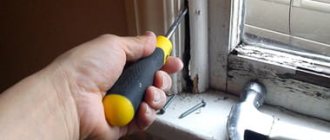Why is it blowing
The reasons for window depressurization can be different. The plastic seals dry out and cracks appear in the slopes. In high-rise buildings, corner windows on the upper floors often suffer - the sashes become warped.
Wooden frames suffer from shrinkage and cracks when the house subsides. Seasonal fluctuations in temperature and humidity are also not good for the tree. Although the shelf life of wood treated with antiseptics is comparable to a person’s life, it also ends someday.
Problems with window sills and slopes require drastic measures - repair or replacement.
Polyurethane foam
Large gaps between the wall and the window frame, under the window sill, are closed with polyurethane foam.
Before work you need to put on gloves and goggles.
- Holding the cylinder in a vertical position, remove the cap from the adapter and put on the gun.
- The container is shaken for 30 seconds.
- The seam is moistened with water or an activator.
- The cylinder is turned over into the working position and work begins.
- The seam is filled using a zigzag motion. If the seam is vertical, then the movement begins from the bottom up.
- If there is foam left in the can and you want to use it, do not remove the gun. Just clean the outside.
The release of foam is accompanied by a sharp increase in volume, so it is necessary to install safety struts against window deformation.
To solve the problem with cracks in frames, you can use old-fashioned methods or buy ready-made insulation in the store.
Types of insulating tapes and tape
For sealing use:
- masking tape,
- groove and self-adhesive seals,
- adhesive tapes.
Self-adhesive insulation is:
- foam rubber,
- rubber,
- polyethylene,
- polyvinyl chloride (PVC).
In addition, for work you may need:
- mastic for frames,
- reflective film,
- silicone sealant,
- cotton wool, foam rubber, paper or plastic film.
Preparing the window frame
Before pasting, first fill the gaps. To do this, you can take silicone or acrylic sealant, which is used to fill the gaps between the frame and the window sill, between the glass and the frame, and in the frame itself.
All work is carried out at a temperature not lower than +5°C. Surfaces must be dried and degreased.
It is better to seal the gaps between the sashes from blowing with materials that can be easily removed, so that in the warm season you can ventilate the room and wash the internal surfaces of the window. Depending on the width of the gap, in descending order the following are inserted: strips of foam rubber, cotton wool, tubes of newsprint, polyethylene.
Sealing glass in wood windows involves removing the glass, stripping the wood of old caulk, sanding it down, and then applying sealant. The glass is pressed down and secured with glazing bead. Carefully hammer in the nails. Now for several years you can forget about rattling glass and drafts.
Instead of silicone, you can use regular putty or children's plasticine, but their shelf life is noticeably shorter. In addition, you can choose transparent silicone. It will not be noticeable even if the work was not done very carefully.
Foam rubber delays the passage of cold air better if it is laid loosely, maintaining volume. Cotton wool is used in dry places, in the upper transoms. It is more convenient to work with something sharp and thin - a knife blade, a plastic triangle, a ruler.
Industrial seals significantly simplify the task of retaining heat in apartments and houses.
Openwork thin products
Many people like to cut out snowflakes from napkins. This is not difficult to do, you can even use certain established patterns in the form of samples, but many people are concerned about how to glue snowflakes to windows made of such thin material. There are several options, but one of them is the most suitable for a napkin - this is the use of gel.
The gel is very easy to prepare. To do this, you can take white soap, which is sometimes used for washing. Rub a small amount of soap into a deep bowl and then immediately pour boiling water over it, stirring constantly. The result is a homogeneous white mass, which is called a gel.
After this, this glue is carefully but quickly applied to the cut out snowflake using a watercolor brush - the gel and the snowflake are attached to the glass. It is done quickly because the material is very thin and instantly absorbs moisture. Some apply the product not to the product, but directly to the glass, and remove the excess using a piece of foam rubber or cloth.
If you don’t have a watercolor brush, then you can use a foam sponge, which will easily help with gluing. Moreover, after drying, the gel does not leave any unpleasant stains, it is completely transparent, which is convenient. Compared, for example, with double-sided tape.
Seals for preparing windows for winter
To prevent blowing through loose frame sashes, it is enough to insert a seal into the grooves or glue its analogue on an adhesive basis. Insulation without glue is also produced. They are cheaper, but choosing a retainer can leave you with some difficult choices. You can use silicone sealant, but it will leave marks and can remove paint from wooden frames.
A seal is a hollow tube that prevents heat from passing through the cracks due to the layer of air it contains.
Depending on the material, the tubes are
- rubber – grayish-white in color, moderately plastic, subject to damage by acids and alkalis, can peel off when exposed to water, last up to 3 years;
- silicone - pure white, elastic, do not react to chemical influences, perform their functions for up to 8 years in a row.
Window seal
Seals are secured at home in various ways.
- The adhesives are released from the protective film and pressed to the surface of the frame with an adhesive base.
- Tubes with a T- or Y-shaped longitudinal holder are inserted into the groove. This type of fastening is the most reliable and is not afraid of dampness.
- Tubular seals without an adhesive layer are glued to glue or silicone.
The protective film should be removed a few centimeters at a time so that dust and moisture do not get on the adhesive base. Be careful not to stretch the seal so that it does not “bounce” off the frame.
Even before the advent of tubular ones, foam rubber strips were produced, and they are still used to plug cracks. Foam rubber does not injure frames and is easy to use. The downside is insufficient reliability; with strong compression, it loses its heat-saving qualities.
Material selection
The choice of material should be based on the best characteristics for the given conditions. Each material has its own characteristics, which are taken into account when choosing it to cover a window. All materials differ in cost. This also needs to be taken into account.
Paper putty
Window paper is also called paper putty. It is one of the cheapest and simplest means. To prepare it, you only need paper, for example, newspaper, and water; to increase its effectiveness, you can add crushed chalk or clay to the resulting mass. This composition has high plasticity and is also easy to clean while it is wet.
The method is quite common due to its ease of preparation and minimal cost, as well as ease of removal. Insulated openings can only last one winter season. In addition, if you seal the windows with paper, the sealed windows cannot be opened. Paper putties are not used in harsh winter conditions, that is, if too much wind blows through the window, the seal will be compromised.
Paper tape
The fastest way to insulate windows is to use paper tape. It has a number of advantages, including low cost and speed of application, but it also has a number of disadvantages. In this way it will not be possible to reliably insulate window frames. In strong gusts of wind and drafts, the window tape will come off, and this also applies to severe frosts.
Window tape rarely lasts throughout the winter. A window pasted in this way must be covered with a special compound before preparation, then the effect will be better.
Cotton wool or foam rubber
Cotton wool or foam rubber is suitable for pasting. It is worth considering that special technical wool is sold only in large quantities. This method is ideal for sealing large gaps that form in the sashes, at the junction with a wall or window sill.
To get rid of small cracks, use adhesive tape. This will help to better insulate and also act as a decorative element. With this method, you need to spend money not only on basic, but also on auxiliary materials.
Tape for sealing windows for the winter
Adhesive tapes are divided into:
- Paper . Adhesive paper tapes are inexpensive and are placed on clean joints with sealed cracks. As a budget option, ordinary paper tapes are used, which are lubricated with wet soap or flour paste. The last option is so reliable that it may make you regret using it in the spring.
- Rubber (EPDM) , close small gaps well, do not allow air to pass through, withstand temperature changes from -50°C to +70°C, are easy to use - they are fixed well and are also easy to remove.
- Silicone . An advantage to temperature endurance is chemical inertness. Due to its plasticity, this tape will close large uneven cracks without losing the quality of sealing. It is more expensive than tapes made from other materials, but it justifies its cost.
- PVC . The porous structure gives the tape dustproof characteristics. The downside is low thermal insulation. It is painted under frequent temperature changes, but will serve well for one season.
Scotch tape for window insulation
Scotch tape is a name for painting tapes with a different base, on which an adhesive layer of natural or artificial rubber is applied. The base can be paper (crepe) or PVC. There are other varieties, but they are not suitable for covering windows.
Crepe paper differs from regular paper in that it has a corrugated surface. This gives it additional moisture-retaining properties.
Correct installation of window covering paper
Rice. 5. Installation of paper for covering windows.
Before starting insulation, the window must be prepared. It needs to be cleaned well. If there are elements of old insulation left on the frames, it will have to be removed. The frames will need to be unscrewed and the glass washed. After this it needs to be dried. Pasting wood that has not dried out will make the insulation vulnerable to strong winds, as it will not allow the paste to dry properly.
Rolls of adhesive material must be printed. It is necessary to adjust the length of the strips by measuring along the gap.
Well-washed wooden elements to be covered can be additionally degreased. This will allow the paste to “grasp” the frame more tightly. Degreasing can be done with regular vodka. Its strength will be quite enough. You should not use solvents for degreasing, as they can damage the varnish or paint.
Gummed strips need to be moistened, and non-gummed strips need to be coated with glue. Let them absorb the glue a little and then close the cracks with them.
How to seal windows for the winter with masking tape
The work is carried out at above-zero temperatures. In colder times, due to condensation, the adhesive layer on the frames will not hold.
The surface to be pasted must be dry, clean and free of grease. The cracks are pre-insulated. First, prepare pieces of tape of the required length according to the principle “measure twice, cut once.” Then they are applied on one side, stretching a little and pressing tightly. Using the palm of your hand, iron the strips across towards the un-glued side, starting from the middle.
To glue a stepped surface, a strip of one third the width is applied to the protruding side. After carefully smoothing, run your hand along the fold to the corner. Finish by fixing the edges around the corner. All actions are carried out from the middle of the strip.
Distortions that cause folds in the tape are undesirable. In winter, the movement of air towards a warm room in these places will cause the tape to come off first.
Masking tape is good because it can be easily removed with active wetting in the spring. Its disadvantage is this: in the cold season it lags behind when there is excess humidity.
Dishwashing liquid
Liquid soap, dish soap, or shampoo works about the same as soapy water. These are fairly thick liquids that, when dry, will hold the paper well on the glass. You can apply them to the snowflake with a brush. It is enough to lubricate light specimens from napkins in fragments, applying a little of the composition to the edges of the rays. It is better to cover heavy snowflakes made of thick paper completely with the product and press it with a sponge, straightening it on the glass.
It doesn't take much effort to clean off any glue residue. All detergents dissolve easily in water.











